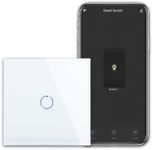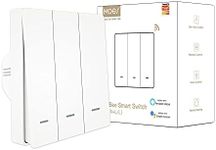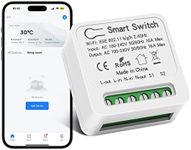Buying Guide for the Best Smart Light Switches
Smart light switches are a great way to add convenience and automation to your home lighting system. They allow you to control your lights remotely, set schedules, and even integrate with other smart home devices. When choosing a smart light switch, it's important to consider several key specifications to ensure you get the best fit for your needs. Here are some important factors to consider:CompatibilityCompatibility refers to whether the smart light switch will work with your existing home setup, including your electrical wiring and smart home ecosystem. It's important because not all switches are compatible with all systems. For example, some switches require a neutral wire, while others do not. Additionally, you should check if the switch works with your preferred smart home platform, such as Alexa, Google Home, or Apple HomeKit. To pick the right one, ensure your home wiring supports the switch and that it integrates seamlessly with your current smart home devices.
Control OptionsControl options refer to the different ways you can operate the smart light switch. This can include physical buttons, mobile apps, voice control, and automation through schedules or sensors. This spec is important because it determines how convenient and versatile the switch will be for your daily use. If you prefer hands-free operation, look for switches with robust voice control capabilities. If you like to manage everything from your phone, ensure the switch has a user-friendly app. Consider your lifestyle and how you prefer to interact with your devices to choose the best control options for you.
InstallationInstallation refers to how easy or difficult it is to set up the smart light switch in your home. This is important because a complicated installation process can be frustrating and may require professional help, adding to the overall cost. Some switches are designed for easy DIY installation, while others might need more technical knowledge. To pick the right one, assess your comfort level with electrical work. If you're not confident, look for switches that are marketed as easy to install or consider hiring a professional.
FeaturesFeatures refer to the additional functionalities that the smart light switch offers beyond basic on/off control. This can include dimming capabilities, energy monitoring, scene setting, and integration with other smart devices. These features are important because they can enhance your home automation experience and provide added convenience. If you want to create different lighting moods, look for switches with dimming and scene setting. If energy efficiency is a priority, consider switches with energy monitoring. Think about what extra functionalities would be most beneficial for your lifestyle to choose the right features.
DesignDesign refers to the aesthetic and physical appearance of the smart light switch. This is important because the switch will be a visible part of your home decor. Smart switches come in various styles, colors, and finishes, so you can choose one that complements your interior design. To pick the right one, consider the overall look of your home and choose a switch that matches or enhances your decor. If you have a modern home, you might prefer sleek, minimalist designs. For a more traditional look, consider switches with classic finishes.
ConnectivityConnectivity refers to how the smart light switch communicates with other devices and networks. This is important because reliable connectivity ensures smooth operation and integration with your smart home system. Common connectivity options include Wi-Fi, Zigbee, and Z-Wave. Wi-Fi switches are easy to set up and connect directly to your home network, while Zigbee and Z-Wave switches require a hub but offer more stable connections and lower power consumption. To pick the right one, consider the existing connectivity options in your home and choose a switch that fits seamlessly into your setup.















